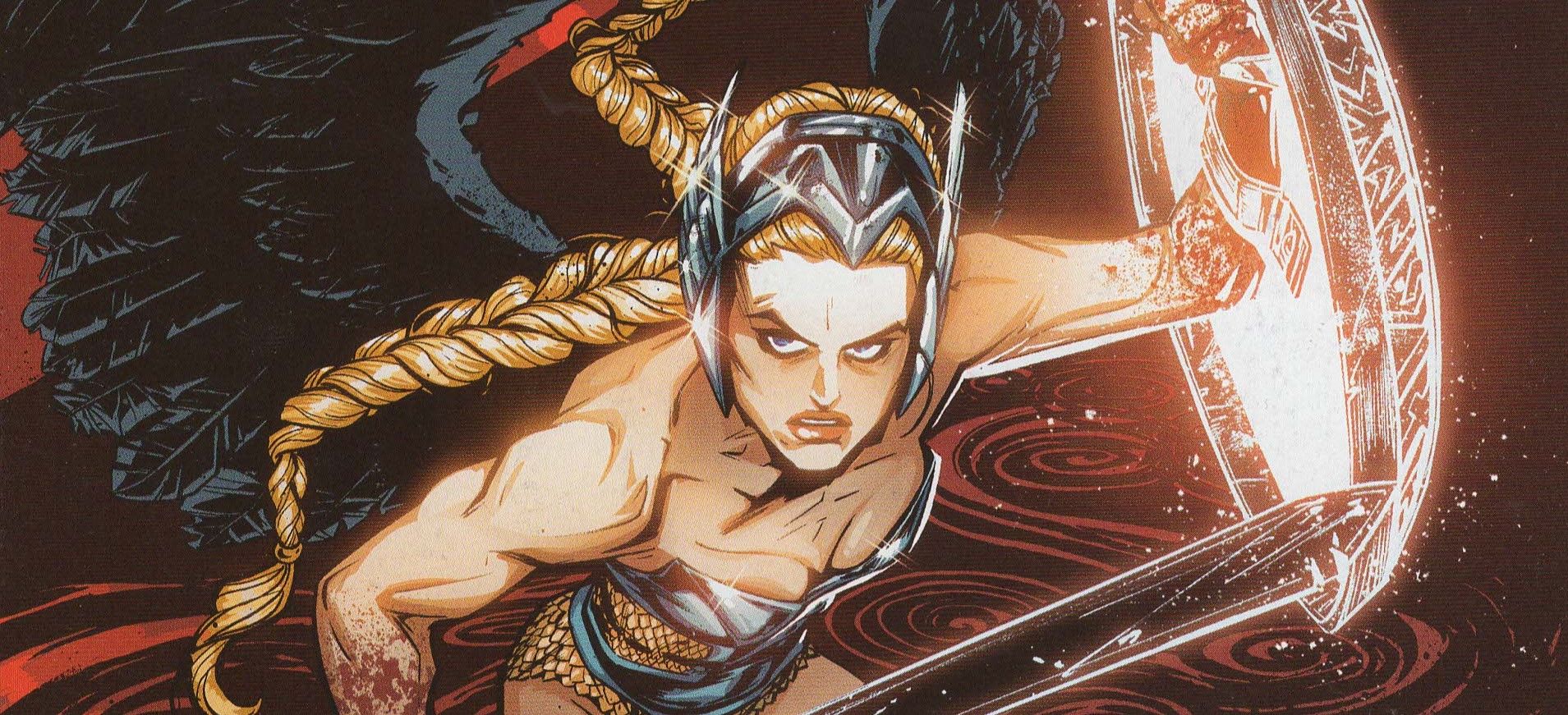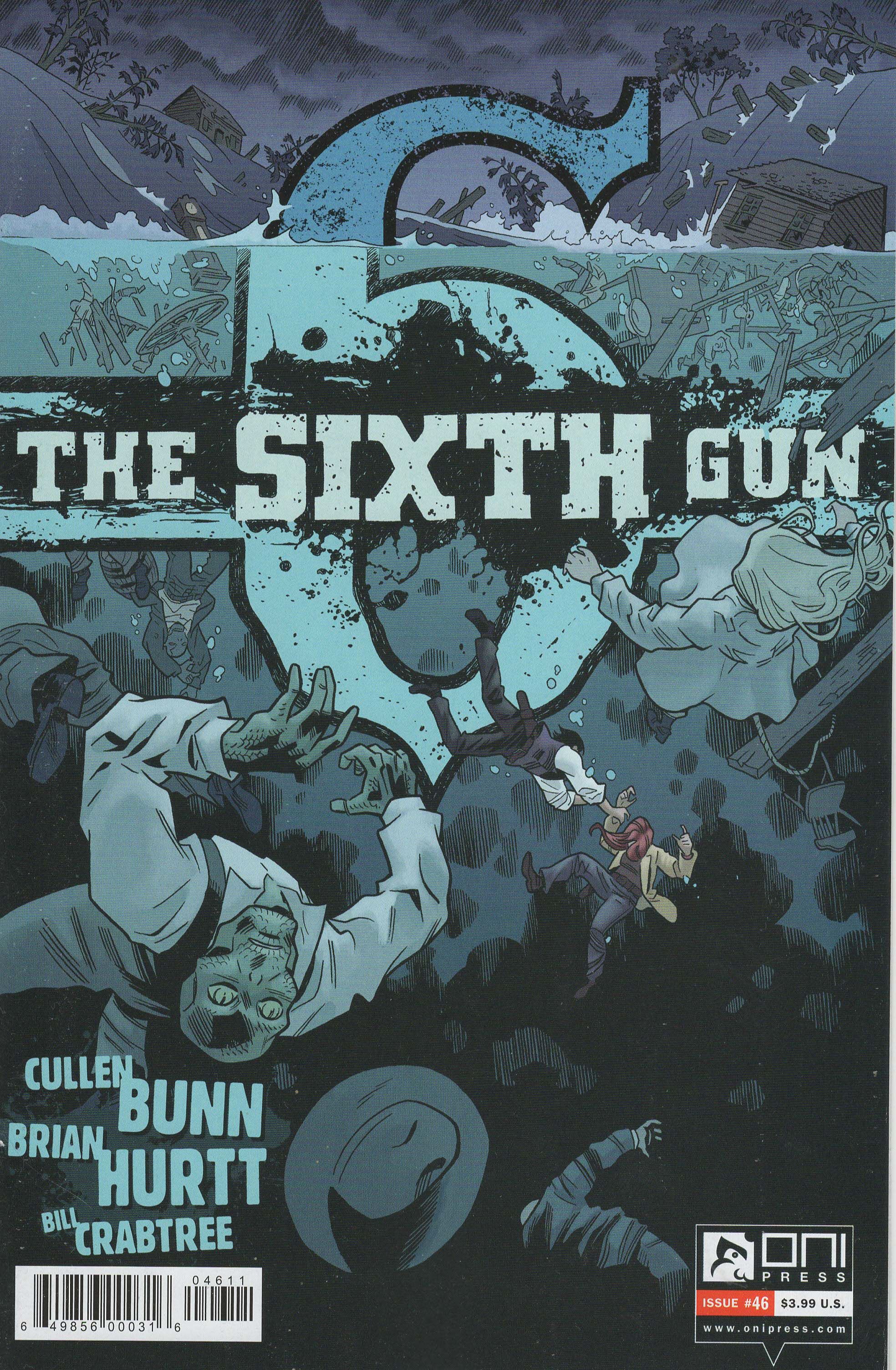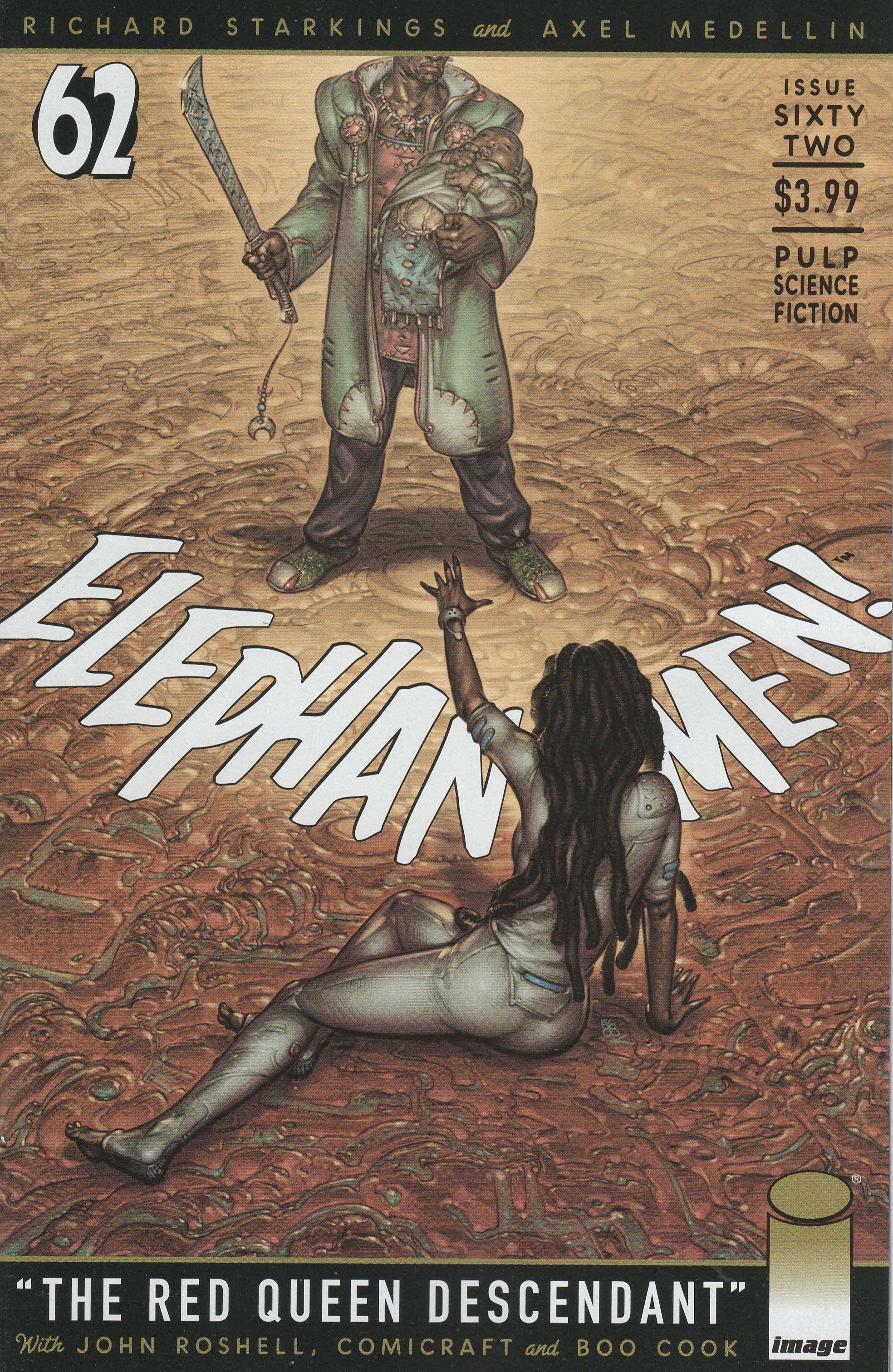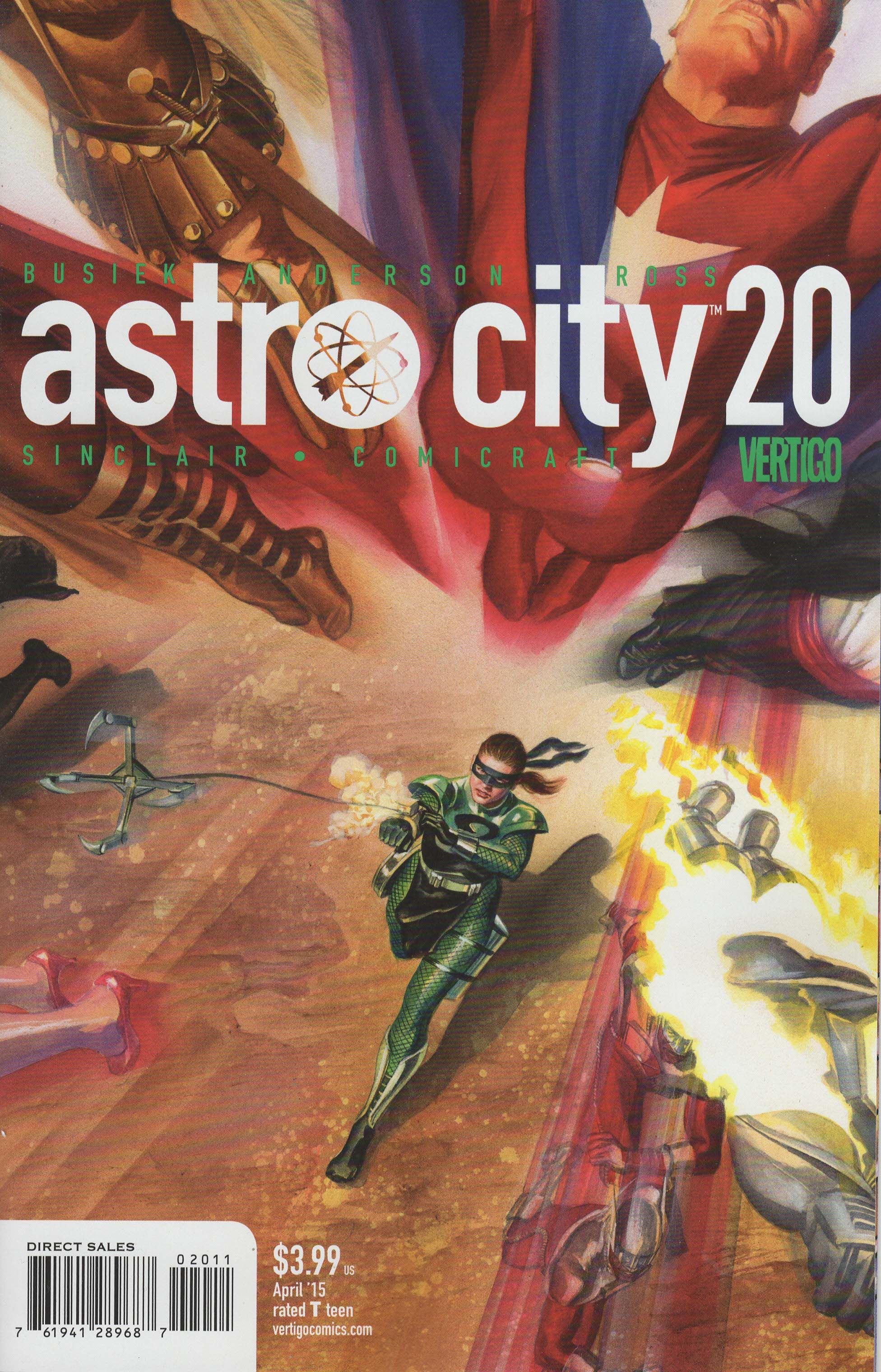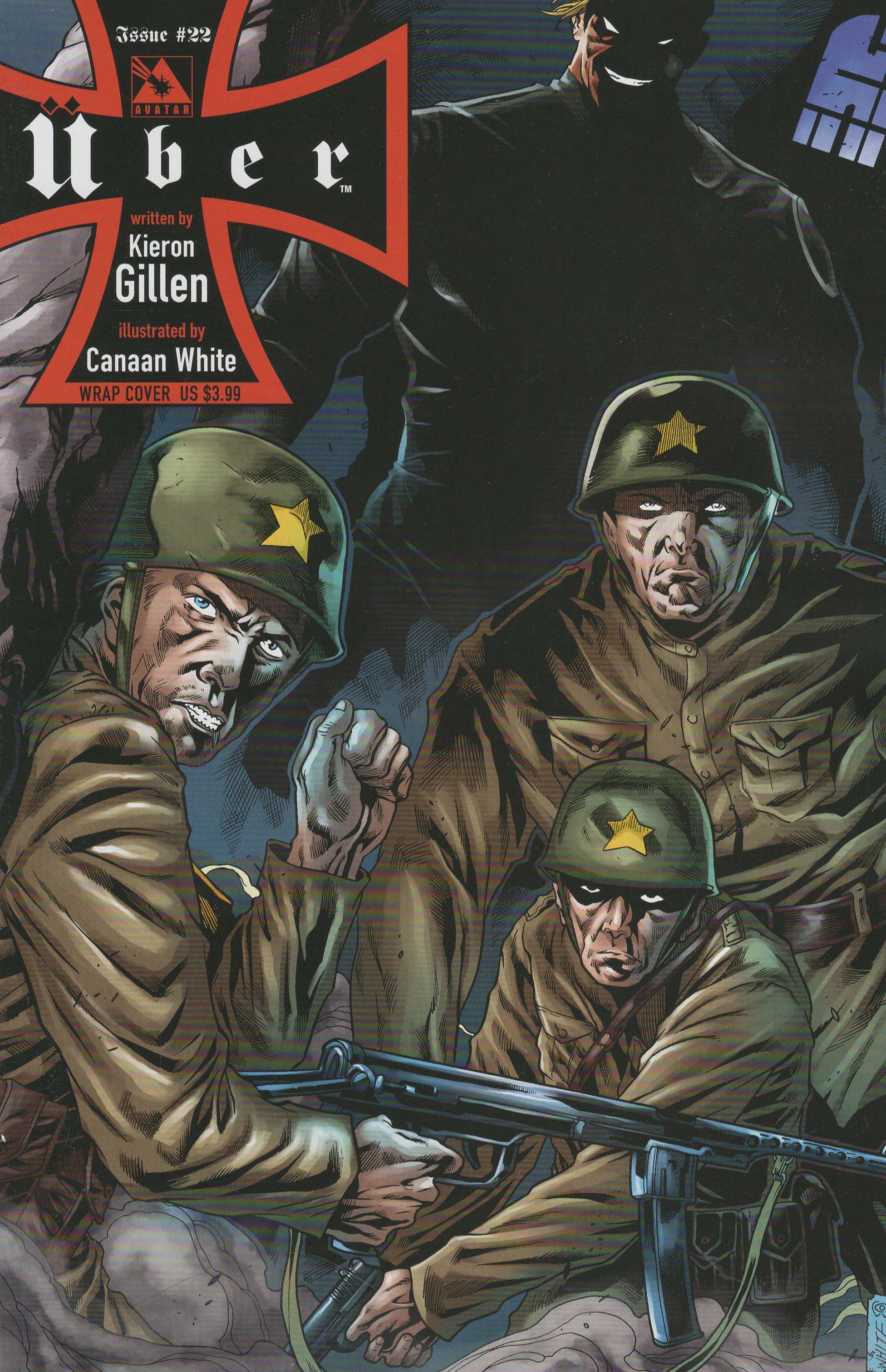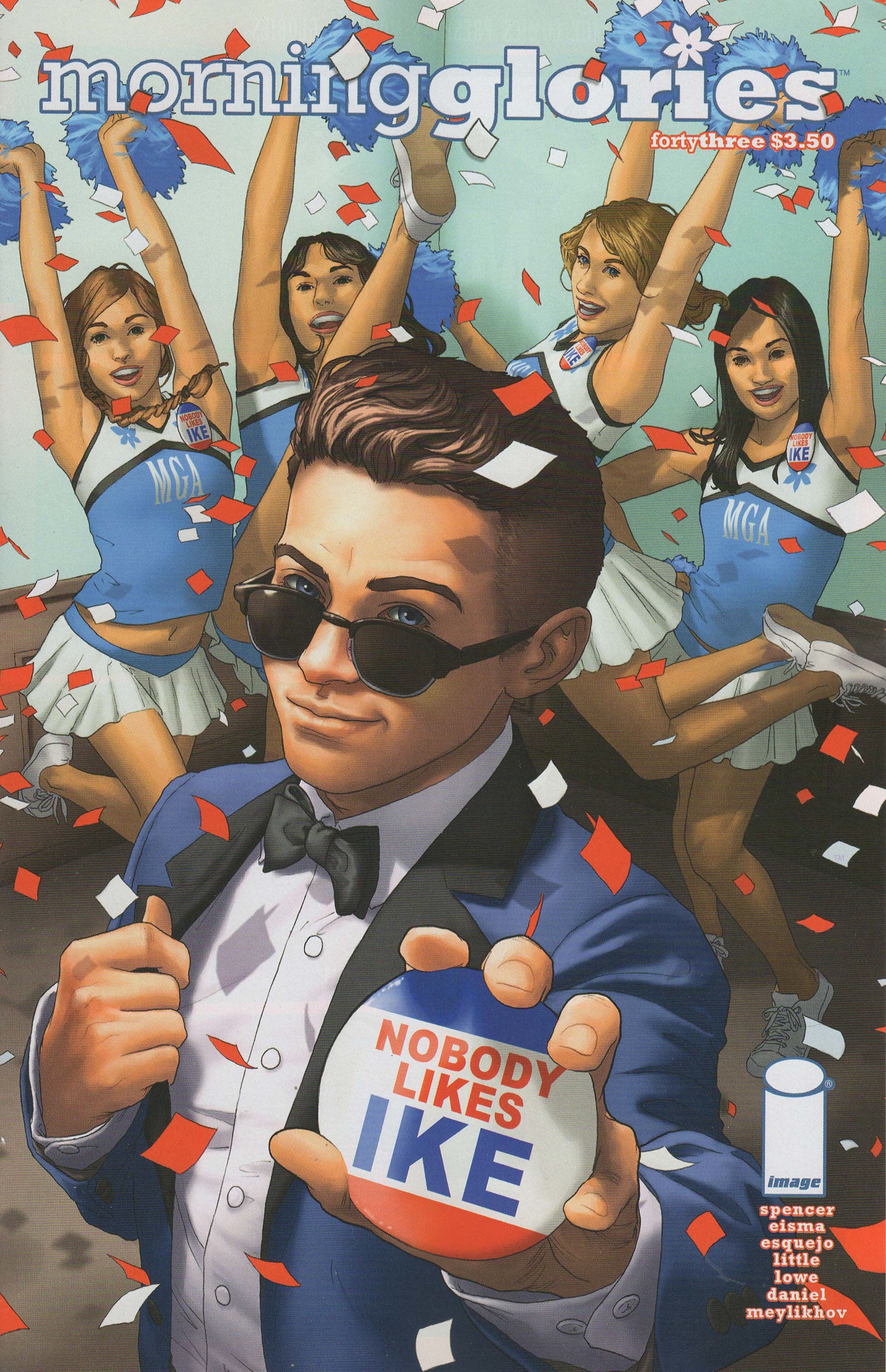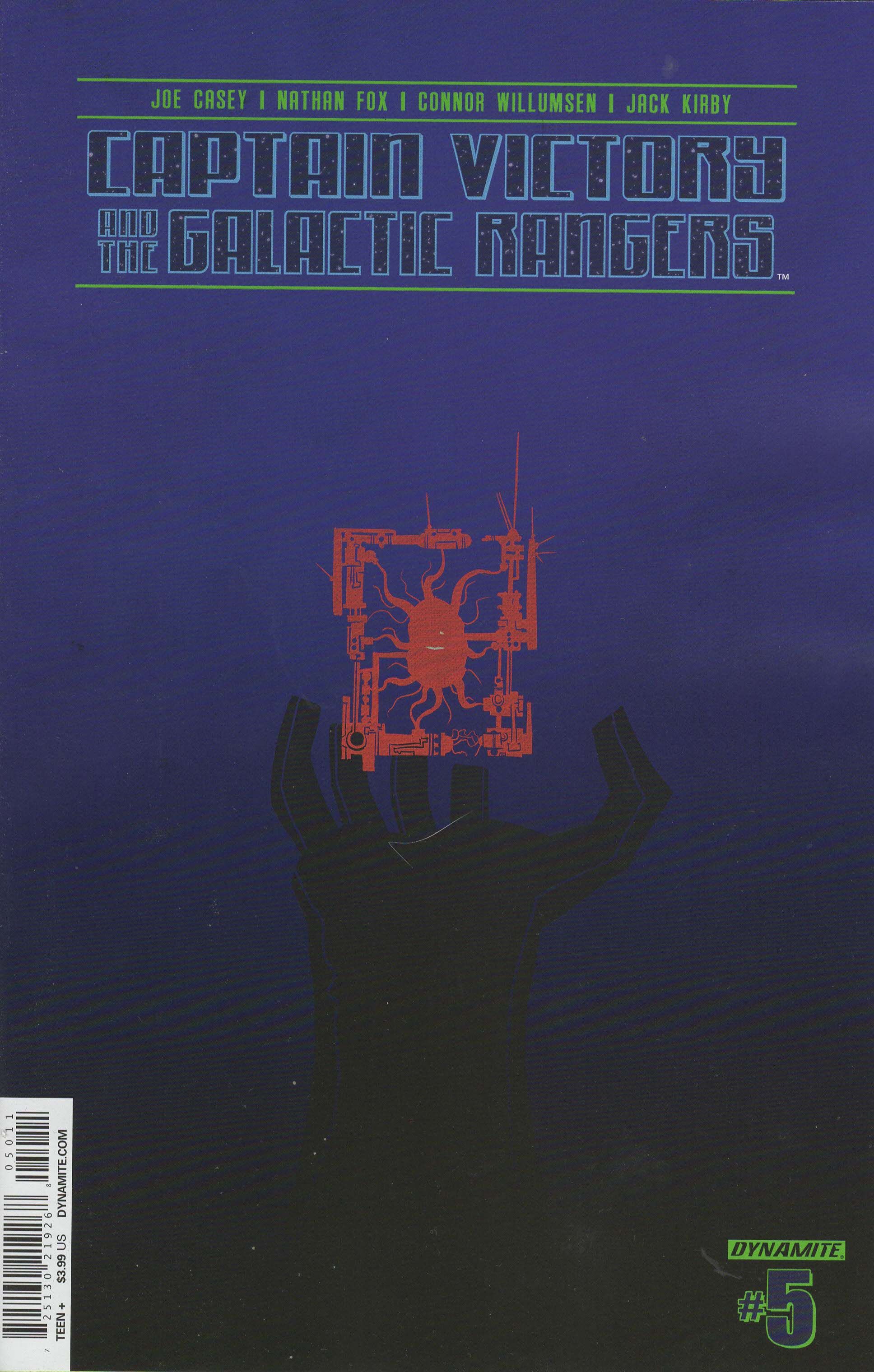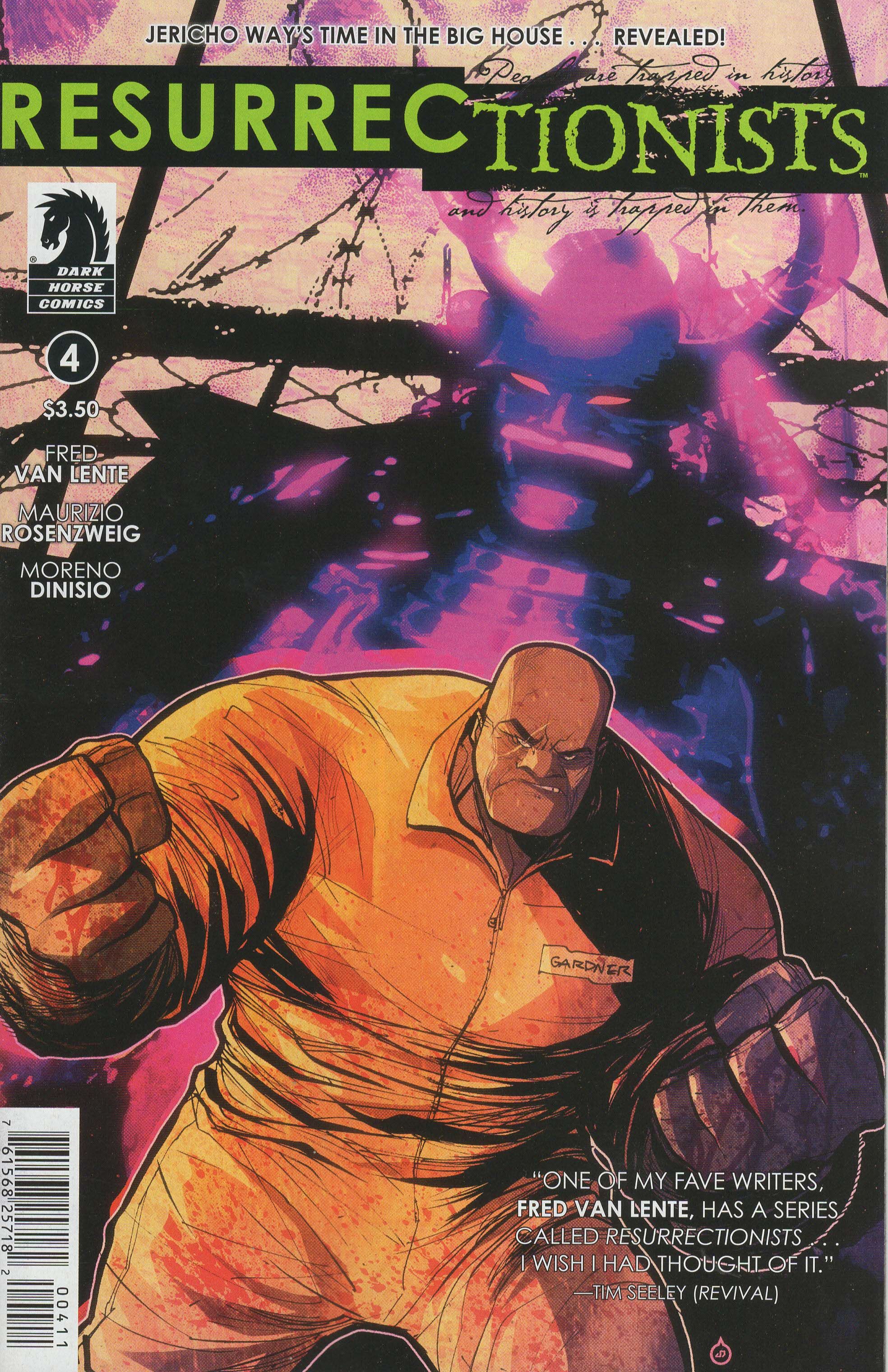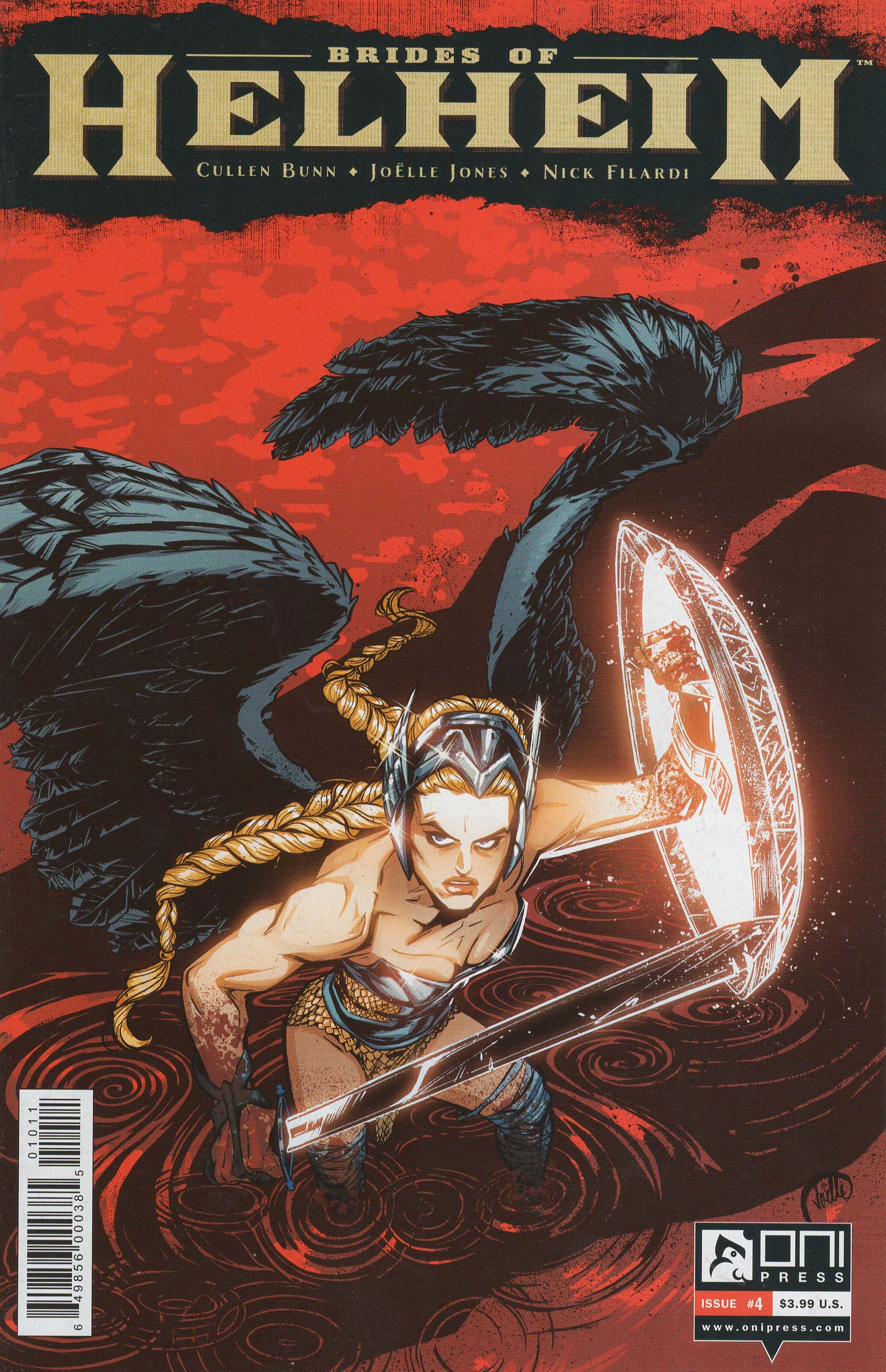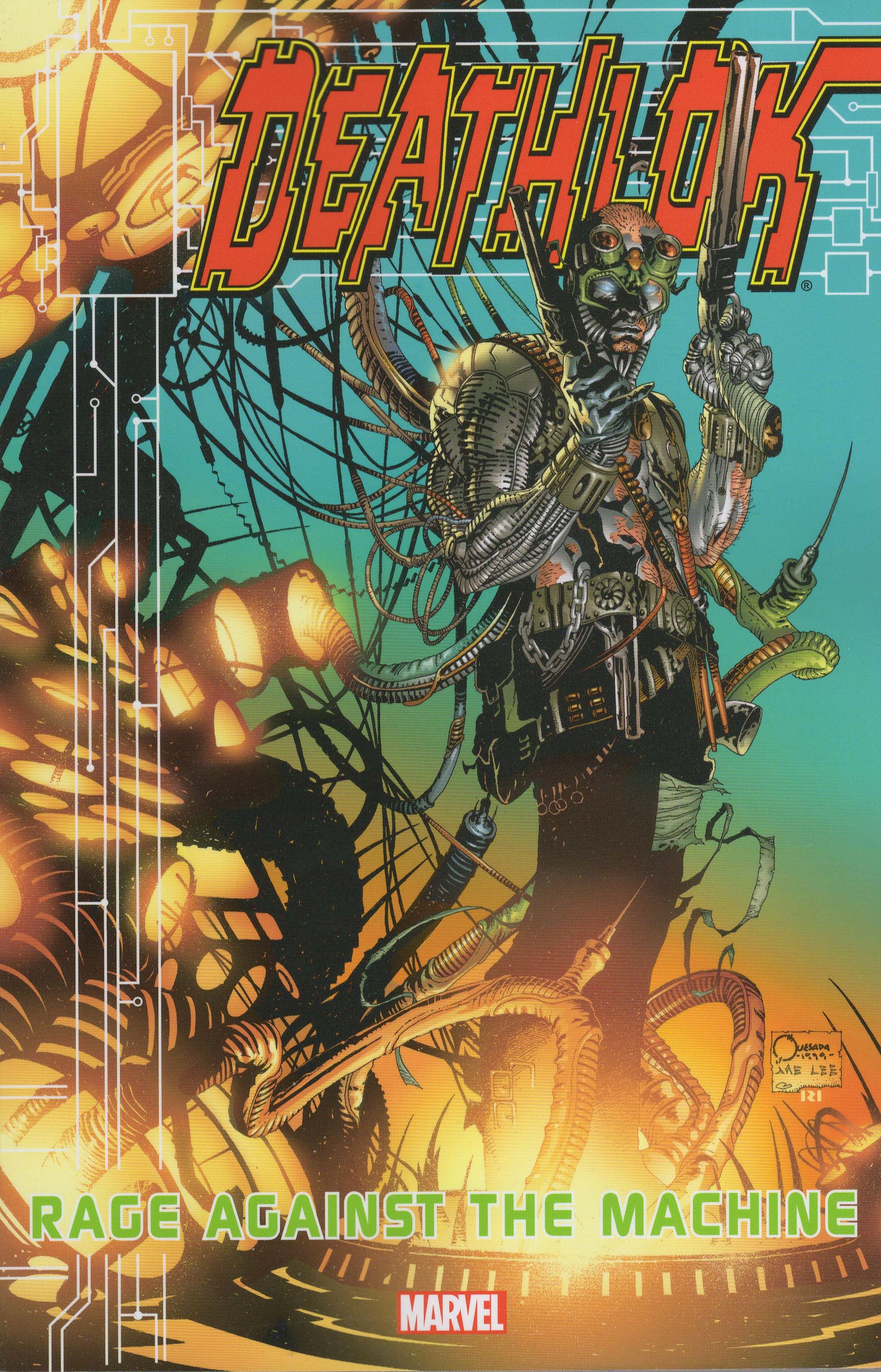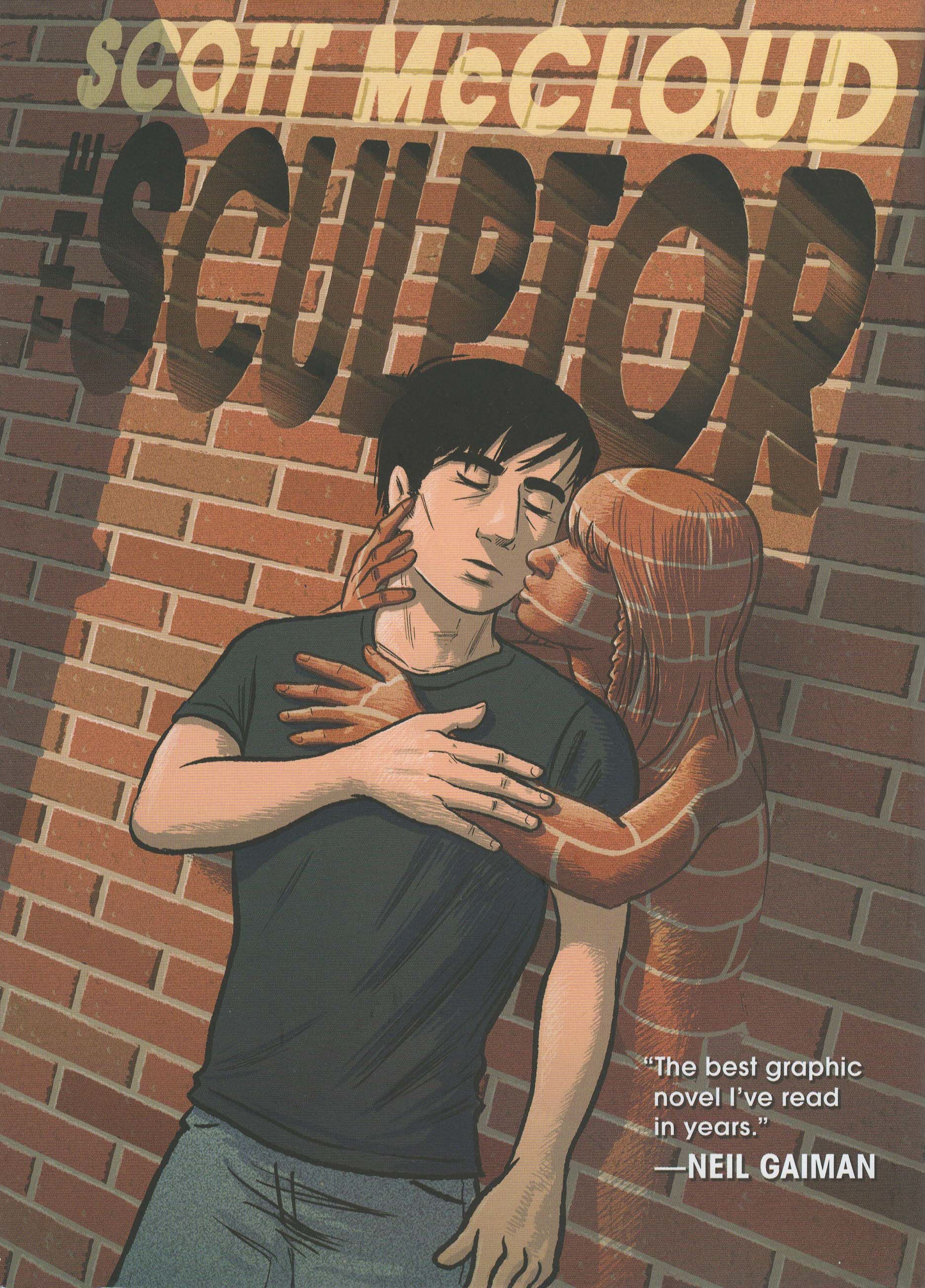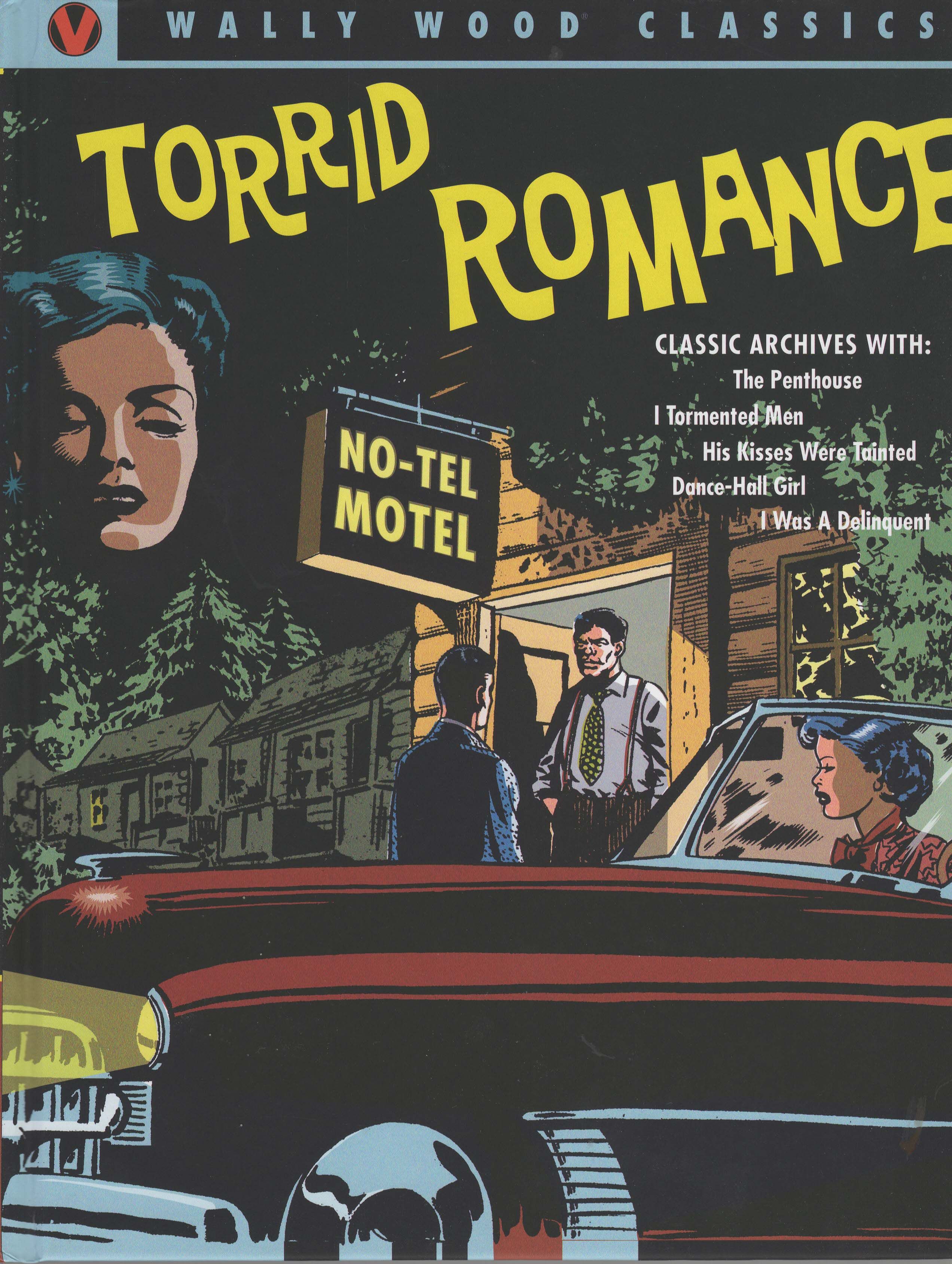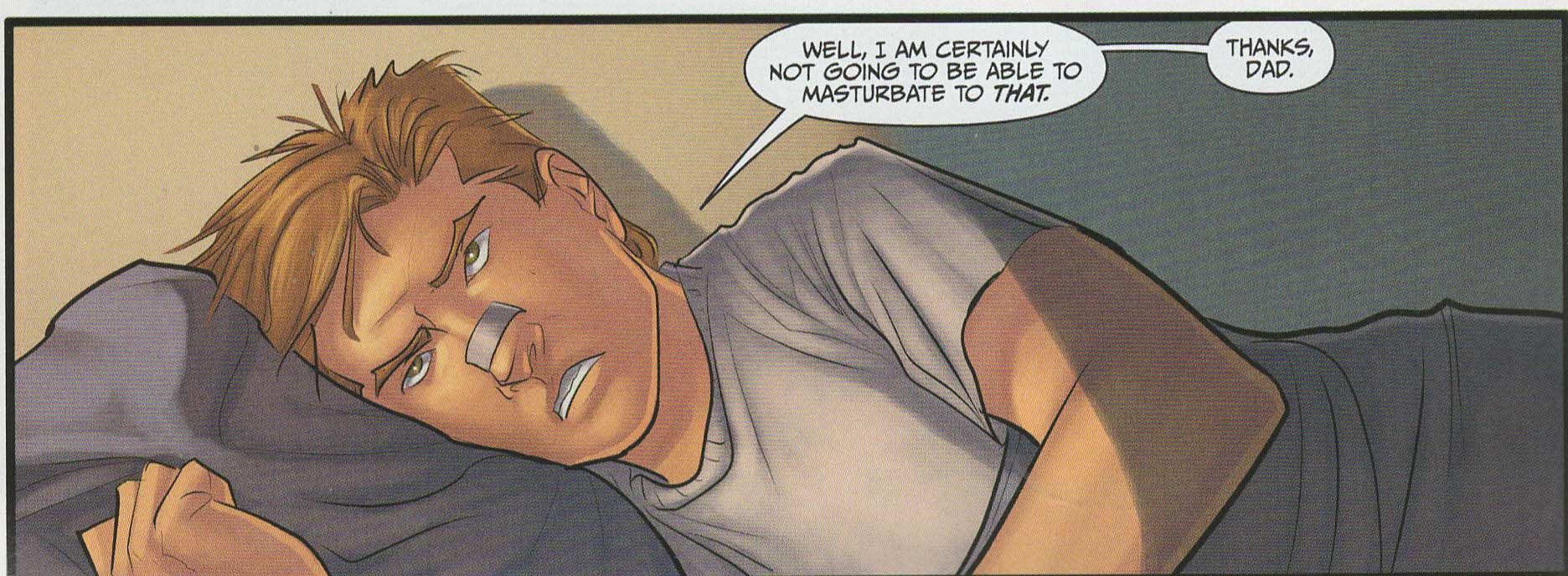In the suburbs people rarely dreamed of striking out for happiness. It was all familiarity and endurance: security and safety were the reward of dullness. (Hanif Kureishi, from The Buddha of Suburbia)
The Sixth Gun #46 ("Hell and High Water Part Five") by Cullen Bunn (writer), Bill Crabtree (colorist), Crank! (letterer), Brian Hurtt (artist), and Charlie Chu (editor). $3.99, 24 pgs, FC, Oni Press.
Last week I mentioned that the spin-off mini-series of the main title aren't all that essential, as they're entertaining but fill in very small plot points that probably don't need to be filled in. This makes the main title, which is still one of the best comics out there, that much better by comparison, as this week we get another issue of the main title, as Bunn and Hurtt hurtle toward a conclusion (I think the next arc is the final one, although this one sure feels apocalyptic, doesn't it?). Obviously, in any end-of-the-world scenario, there has to be a time when the bad guys appear to have won, and there's usually some kind of countdown. Griselda has, apparently, broken open the seals to destroy our world, but she does mention that because it took God six days to make the world (man, that God was a piker!), it will take six days to unmake it. That either gives Becky, Drake, and Nidawi enough time to stop it or it means that they will believe they can stop it because they have enough time, but in the end it just won't be enough (I certainly wouldn't count out Bunn destroying the world in this comic - it's fiction, right?). Of course, Becky, Drake, and Nidawi are woefully outgunned, so who knows how Bunn will even get them to a place where they can challenge Griselda, but let's not worry about that now.
One reason why this comic is so good is because Bunn has done such amazing work with Becky. Drake has become a more interesting character over the course of the title, but Becky holds it all together, and her desperation, rage, and strength is on full display in this issue. She also shows her humanity, as she's so happy to see Nidawi at the end of the issue after she thinks the Indian is dead, and the small emotional moment (which takes Nidawi by surprise) is terrific, as Bunn lets us know how much she misses the people she's already lost by clinging to one of the survivors. It's nicely done, and Hurtt does an excellent job with it, as well. Hurtt, as usual, is amazing on this issue, even though I don't love the way he and Crabtree use the thin white paint to show rain, as it obscures too much of Hurtt's line work. However, when the lizard dudes chase Drake through the houses, Hurtt does a wonderful job, as the flood outside pummels the buildings and Hurtt shows how it affects the people inside. The way he choreographs the scene is really well done, as the characters have to maneuver rooms that have been turned on their sides and have water flowing through them. Hurtt also nails the many emotions Becky is feeling, from her rage (see below) to her relief that Nidawi is alive. Hurtt's art has always been phenomenal on the title, but it's still worth mentioning.
Next issue is the final one of the arc, and then, as I pointed out, I think the last arc comes up. It's late in the game, but you should still jump in and read this comic!
Rating: ★ ★ ★ ★ ★ ★ ★ ★ ☆ ☆
One totally Airwolf panel:
Elephantmen #62 ("The Red Queen Part Five: Syzygy") by Axel Medellin (artist/colorist) and Richard Starkings (writer/letterer). $3.99, 25 pgs, FC, Image.
For a while, Elephantmen was slowed down a bit, as it seemed that Starkings was building to something massive. Well, this might not have been the something massive he was building to, but this is still a game-changing issue, as Serengheti interrupts the wedding of Sahara and Obadiah and wreaks some havoc. I don't want to spoil too much of the issue, but Sahara's father has been on a crusade against his daughter marrying Obadiah and bearing his child for a while now, so blood will be shed. Even though we know it's coming, it's still intense, as Serengheti is a bit more of a douchebag than even he's shown prior to this issue. Something happens that makes one of my theories about the future of the story (as some of it has already been told) moot, too, so there's that. Starkings has always examined what makes people and hybrids civilized, and naturally there's always a thin veneer of civilization over the brutal aspects of a species, so it's not surprising the way some characters act, especially as Starkings is not interested in making all the humans evil and he never forgets that the elephantmen were bred as warriors. It's one reason why the comic has always been so good - Starkings isn't that interested in writing some kind of polemic, so the fact that men bred the hybrids is horrible but doesn't condemn an entire species, while the fact that Hip is a "good guy" (as he points out in this issue, "or whatever passes for one round here today") doesn't mean that other hybrids are great people. Obadiah and Sahara's affair has been a focal point of the book, but so is Hip's relationship with Miki, and both are very different. Starkings doesn't write these kinds of issues just to clear the deck and shock the readers, he does it because this is what these characters would do. Which, of course, makes it more brutal to read.
One of the problems that Medellin, along with other artists on the series, has encountered is one of scale. The elephantmen tower over the humans, and when they have to fit into smaller panels, it's often difficult to get a good sense of how big they really are. There's a nice drawing of one hybrid punching another in the book, but because the actual panel size is smaller, it doesn't have as much dramatic weight, which is too bad. On the other hand, Medellin gets to draw a double-page spread of Obadiah touching the face of his child, and the sheer size of his hand and arm juxtaposed with something so small and delicate is terrific. He also lays out a wonderful page where Sahara calms Obadiah down, and the way he breaks up her face with panels of Obadiah's angry eye and contrasts her soothing green eyes with his red one is superb. He gets to draw a lot of action, too, and he's good at that, plus he does a wonderful job with the coloring on the issue, as he contrasts the tough hide of the hybrids very well with the delicate skin of Sahara and Panya and the baby (except for ... but that would be telling). When Serengheti and his men begin firing their weapons, tough skin isn't necessarily a defense, but it's a lot better to have it than human skin!
In a comics world that often simply looks to the next new thing, some great comics might get forgotten. The Walking Dead, of course, is an exception, but comics like The Sixth Gun and Elephantmen continue to do an excellent job and have been for years now. I know that Starkings is thinking about wrapping up this series, but it still has a while to go, and it's still a great book.
Rating: ★ ★ ★ ★ ★ ★ ★ ★ ☆ ☆
One totally Airwolf panel:
Astro City #20 ("Doing Battle") by Brent Eric Anderson (artist), Jimmy Betancourt (letterer), Kurt Busiek (writer), John G. Roshell (letterer), Alex Sinclair (colorist), Jessica Chen (assistant editor), and Kristy Quinn (editor). $3.99, 24 pgs, FC, DC/Vertigo.
Busiek, of course, is one of the best superhero writers around, so the fact that he's left them behind except for Astro City means that we'll have to appreciate his work on this that much more. As always, he uses AC to explore things we don't usually see in superhero comics, and the fact that the book moves in "real time" (which Busiek doesn't take enough advantage of, in my humble opinion, given that so many of his characters don't age very much) lets him write stories like this current arc, where Quarrel and Crackerjack deal with aging. Quarrel has been feeling her age, and Busiek makes interesting points about the thrilling and addictive nature of superheroics - which is why Jack doesn't want to quit - without making it too obvious (although it is a superhero comic, so that kind of thing comes with the territory, so Busiek isn't that subtle about it). Because Busiek is not a lazy writer, he manages to do quite a bit more than that, too - Quarrel is getting older, sure, but because she doesn't have superpowers, she isn't immune to the ravages of time like so many others in the Honor Guard. This means she doesn't have time for a "normal" life, as she needs to constantly train to keep up. This also leads into the end of her relationship with M.P.H., as he doesn't understand her desire for a "jerk" like Jack - she doesn't think she has time for a "normal" life, and Jack doesn't either, so even though they break up a lot, she goes back to him because he leaves her alone and doesn't ask for more. She doesn't understand that she could, after all, give it all up, while M.P.H. doesn't understand that he doesn't even have to make that choice - he can get married and have kids and still be a superhero because he has superpowers, while she would have to make a deliberate choice to go with one or the other. She chooses being a superhero, and that means she can't do anything else. She begins to realize the toll it's taking on her, but Jack doesn't, and that leads to the conclusion, where Jack does something stupid, and Quarrel is going to be put in an even more awkward position. Busiek always has the most superheroey of superhero stuff in the back of his mind, so the book never drags, and it's impressive as much "real-world" stuff he can get into a comic where, in one panel, a villain dressed in dominatrix gear and a woman dressed in a bikini and covered in what looks like cotton candy attack Quarrel and make boners the comics-reading world over feel really uncomfortable. That's just Busiek being Busiek!
Of course Astro City is still a good comic! Did you expect anything less?
Rating: ★ ★ ★ ★ ★ ★ ★ ½ ☆ ☆
One totally Airwolf panel:
Über #22 by Digikore Studios (colorist), Daniel Gete (artist), Kieron Gillen (writer), Kurt Hathaway (letterer), and Caanan White (artist). $3.99, 22 pgs, FC, Avatar.
Über is not quite in the same category as the first three comics here, but Gillen's alternate-history World War II story has quietly chugged along, with Gillen slowly building a nice mythology, as his superheroes have killed Churchill, killed Hitler, stopped the Manhattan Project, and driven the Germans from Russia. In this issue, Gillen drops a couple of other surprises on us about actual historical figures, but this issue, along with this entire arc, has been what he calls "The Shadow War," so the actual battling has been kept to a minimum (although last issue, Maria fought Klaudia, so there was that). In this issue, Stephanie manages to escape from the German spy that she was banging (of course, she didn't know he was a spy when she was banging him), Maria does something surprising but also perfectly reasonable, Joseph Goebbels makes a momentous change, and the British learn something crucial. Gillen has managed to keep the story from becoming just a crazy punch-out between superpowered beings, as he's explained why they're not unstoppable. He also manages to frame the horrors of the war within the superhero context, and while Gillen (in the backmatter) writes about how terrifying it is for him to even hint at a comparison between the Holocaust and his comic, he doesn't need to make the comparison, because I'll make it for him. Instead of showing us horrors that should not be in this kind of comic, he uses the superpowers program by all the countries involved - including the United Kingdom and the United States - to show how the people in power put the common people through a meat grinder with no regard to their feelings. Some embrace it, of course, but we also see the cost, as many, many "specimens" don't survive the process. Without being explicit and without making it a pure one-to-one comparison (those who die trying to get superpowers are not killed simply because they're, say, Jewish), Gillen is able to imply the moral horror of war, no matter which side is "right." As we get further into the story, he's gotten better at it. That's nice to see.
The biggest problem with Über has always been the artwork, or more specifically the coloring when it's combined with the pencils. I met Caanan White a few years ago when he and Gillen were in Phoenix for the convention, and his straight pencils are terrific. Like a lot of artists these days, especially when they're working for Avatar or Dynamite (but not limited to that, as too many DC and Marvel books show), the pencils are overwhelmed by the coloring, as the digital rendering strips the pencils of far too much of their personality. I haven't seen Gete's raw pencils, but I imagine it's a lot of the same. White is a pretty good artist, and I'd love to see him get matched up with an inker and/or colorist who doesn't overwhelm the line work. He's leaving the book and Gete is taking over, so we'll see what happens with that, but I still don't have any idea why Avatar and some other companies think this kind of digital coloring is a good idea. I guess it's cheaper, but digital coloring is digital coloring, and a lot of digital colorists are very good at using flatter colors that don't obliterate the pencils. But I guess someone likes them!
Next: "A great deal of burning," according to Gillen. Oh dear.
Rating: ★ ★ ★ ★ ★ ★ ½ ☆ ☆ ☆
One totally Airwolf panel:
Morning Glories #43 by Joe Eisma (artist), Paul Little (colorist), Johnny Lowe (letterer), and Nick Spencer (writer). $3.50, 30 pgs, FC, Image.
A few years ago, Morning Glories was one of the best comics out there, and things were looking up. Then, something happened. I'm not sure what. Did Spencer get a bit too ambitious, and with the introduction of the "second class" (I know they were there first, but they were introduced second, so I'll call them that), have too many characters and therefore lost some emotional connection I had to the "originals"? Is the time travel aspect of the story just too annoying to me? Has the delayed scheduling killed the book's momentum? I think it's some of all of this, plus the fact that Spencer doesn't really seem to be interested in, you know, resolving anything. The "second class" diversion has, it seemed, turned into just that, a diversion, and we're back with the "originals" as the focus, but without the connections they used to have, as contentious as they once were. Yes, it's nice to see Ike and Casey verbally sparring again, but Spencer continues to move around in time, and I just can't care that much, especially as it takes so long for him to get back around to plot points. As I've mentioned before, I'm not the sharpest tool in the shed, but I do try to keep up. Spencer assumes that we're going to re-read the entire series every time a new issue comes out just so we can recall what happened in one panel in issue #15. It's somewhat exhausting reading an issue of Morning Glories these days, which is too bad. Yes, that's probably because I'm not the sharpest tool in the shed, but I've written about this before, so it's been going on for well over a year. The fact that the book comes out very, very sporadically makes it even harder to keep up with everything. It's frustrating, because there's nothing that I really hate about the comic. Each issue is well-written, well-drawn, and it has some nice interaction between characters and Spencer certainly has a handle on the unique voices of each character. He just seems to think that whatever epic he's telling is so interesting that he can draw it out forever, but it's been four-and-a-half years, and what, really, has been resolved? A few characters have died, but it doesn't feel like we're any closer to any actual answers except that a lot of things happen because of time travel. I wrote a while back that I'll stick with it through issue #50, and I probably still will, although the snail's pace of the scheduling makes it unlikely we'll see that issue this year. I assume that issue will end the "second season" (blech) of the title, and Spencer will do something big. After that, I'll have to think about keeping up with it. Until then, Morning Glories is likely to remain the most frustrating comic I read. Sigh.
Rating: ★ ★ ★ ★ ★ ★ ☆ ☆ ☆ ☆
One totally Airwolf panel:
Rogues! The Burning Heart #2 (of 3? of 5?) by Miguel Angel Castillo (colorist), Malaka Studio (letterer), Juan José Ryp (artist), El Torres (writer), and Sandra Molina (editor). $3.99, 26 pgs, FC, Amigo Comics.
On the inside front cover of this comic, it refers to this as "issue two of five." On the inside back cover, it refers to this as "#2 (of 5)." On the page facing the final page of the story, we learn that next issue is the "grand finale" of this saga. So does that mean that the final two issues will be a completely different story? Or is it really only three issues long and someone screwed up? I don't know. I just notice these things, don't I?
While this story arc has been published after we've already been introduced to Bram and the Weasel, it's their first series, as Torres and Ryp worked on it together years ago in Spain and this has been "remastered" for release in the States. None of that necessarily matters; so far, Torres has been writing these as generally standalone arcs, although you can see that the two rogues are a tiny bit more venomous to each other in this series than they have been in later arcs, even though they still like and respect each other here. The comic continues to be a wildly fun one, as in this issue our two heroes have to contend with crocodiles that are trying to eat them for several pages (pages in which Ryp gets to draw the Weasel's boobs a lot, as they fall out of that tiny top she's wearing when she hits the water) before they finally escape. They try to find out more about the big gem they stole, but they foolishly leave it with an unscrupulous character, who can't resist taking a look at it. Yeah, that's a bad idea. Bram and the Weasel find out that it's more than just a gem, which sets the stage for the aforementioned big finale.
As with any buddy story, the plots matter less than the characters, and in movies, if the buddies have chemistry, the movies are better, while in comics, if the writer can write good dialogue (chemistry between two-dimensional figures on a page being less of an issue), the comic tends to work. Torres has shown that he writes these characters very well, even back from this time when he was a newer writer (and Torres seems to know English fairly well, so I assume he translated it himself and perhaps tweaked some dialogue). His heroes bicker like an old married couple, but there's a nice zing to the dialogue, and they really do like each other, so we get a good sense of old friends who know they can snipe at each other without it meaning too much. There's nothing wrong with the plot, of course - death by crocodile is always fun to see, and a mystical gem that might grant people access to an ancient, evil god is never a bad thing - but it's not the most important thing.
Ryp, meanwhile, is fantastic as usual. I know some people don't like him because he's too busy, and that's a fair point, especially as this book is really packed (it's 26 pages long and it feels longer - not in a bad way, but in a "Wow, a lot is going on in this issue" way). Some of his storytelling is a bit wonky because of the details he puts into the scenes and the amount of action he tries to cram into a panel, which makes them occasionally difficult to parse, but overall, he does a wonderful job with the aesthetic of the series, and his sense of humor matches Torres's quite a bit. He makes Clavius more ridiculous as he's ranting about Bram and the Weasel escaping his clutches, for instance, and when our heroes interrupt the oracle at the end of the comic, Ryp does a wonderful job turning her from a mystical conduit to the gods to a confused and awkward young lady very quickly when the spell is broken. He's also excellent at facial expressions, and his sneers and frowns help make the humorous dialogue land better, too. It's always nice to see Ryp's work, and it's pretty darned good here.
Whether this series lasts one more issue or three, it's another enjoyable addition to the story of Bram and the Weasel. It would, of course, be nice if it came out more often, but that's the way it is!
Rating: ★ ★ ★ ★ ★ ★ ★ ½ ☆ ☆
One totally Airwolf panel:
Captain Victory and the Galactic Rangers #5 (of 6) by Simon Bowland (letterer), Joe Casey (writer), Nathan Fox (artist), Brad Simpson (colorist), and Connor Willumsen (artist). $3.99, 22 pgs, FC, Dynamite Entertainment. Captain Victory and the Galactic Rangers created by Jack Kirby.
I really don't have a lot to say about CV&tGR. It's interesting, and Casey is doing some nice things with what is basically a standard rescue mission, but it's also somewhat of a mess (a planned mess, I'm sure, but still). I haven't quite figured out the division of labor with regard to the artwork - Fox is the main artist, and he draws 17 of 22 pages in this issue, but the ones Willumsen draws don't make much sense. Willumsen draws five pages that show a creature terrorizing New York, but Fox draws quite a bit of the creature later in the book, as well. If Willumsen had only drawn the "New York" part of the comic or even the "non-New York" parts, it would have made sense, but he doesn't. So I'm not quite sure why he drew only some of this issue. In the first few issues, it seemed like the artists split the work more logically. But that doesn't seem to be the case anymore, so I wonder why Fox (whose art I like a lot more than Willumsen's) couldn't draw the entire thing. The final issue is an all-star artistic jam (including a certain God of All Comics, which should be interesting), so I'm not expecting consistency, but this issue ought to have some.
That's really all I can think of about this. Maybe I'll have more to write when the final issue comes out. We'll see.
Rating: ★ ★ ★ ★ ★ ★ ½ ☆ ☆ ☆
One totally Airwolf panel:
Resurrectionists #4 by Moreno Dinisio (colorist), Nate Piekos (letterer), Maurizio Rosenzweig (artist), Fred van Lente (writer), Spencer Cushing (assistant editor), and Jim Gibbons (editor). $3.50, 22 pgs, FC, Dark Horse.
Resurrectionists, in case you didn't know, is about characters in the present who are slowly remembering their pasts lives, with one sojourn during the height of the Egyptian civilization a focal point. Jericho Way is the main character, and one other - a woman named Lena - has also "woken up," and the two of them are trying to convince one of Jericho's friends that he too has many past lives. Meanwhile, the bad guy, another dude who recalls his past lives, is planning something evil. You know, like bad guys do. Our heroes are planning some kind of heist to stop him, or at least put a dent in his plans. This ties back to Egypt, where Jericho and Mac - the dude Jericho is triying to "wake up" in this issue - met in a tomb, trying to escape the evil priest-turned-pharaoh who is now the evil businessman. It's all very simple and believable!
It might sound complicated, but it's not, and even if it is, Resurrectionists has been pretty terrific so far. Van Lente is very good at creating interesting characters really quickly, and Jericho and Mac already have a good rapport which we learn more about in this issue, when they're both in prison. The premise is good, a bit complex but not too complicated, and van Lente does a good job linking the ancient Egypt plot to the modern one, not only because it's the "same" characters but thematically, which presumably will become more important as the group begins plotting in earnest against the bad guy. Van Lente links them all quite nicely, and he doles out plot information well, keeping us on the hook as we veer back and forth between the past and the present. Van Lente is a good writer, so it's not surprising that he does this, but if we add the cool premise to the mix, the book really takes off.
Of course, Rosenzweig has a lot to do with it, too. He's great on the book, as well, with nicely distinct characters, a fluid line that makes the action work but a somewhat stocky style that fits the ancient Egypt part of the book really well. Dinisio does very nice work, too, as he uses starker colors and shading in the modern world to contrast with the earthier tones and more subtle shading of the Egyptian parts. The earth tones, which he also uses in the present, help link the time periods, too, which is nice. The art on the book is beautiful, and it fits the slightly noir tone that van Lente is going for.
I've been excited about this book since last June, when van Lente told me about it, and early on, it's really living up to the hype in my mind. That's always nice.
Rating: ★ ★ ★ ★ ★ ★ ★ ★ ☆ ☆
One totally Airwolf panel:
Brides of Helheim #4 (of 6) by Cullen Bunn (writer), Crank! (letterer), Nick Filardi (colorist), Joëlle Jones (artist), and Charlie Chu (editor). $3.99, 22 pgs, FC, Oni Press.
The first series about everyone's favorite undead Viking warrior was good but not great, and I'm not entirely sure why. I wonder if Bunn spent a bit too long on the "origin," which as we know from various superhero movies is the dullest part of any story. I don't think that's necessarily true of Helheim, but maybe it's part of it. Anyway, Brides of Helheim has been more engaging, and again, I don't know why. I think it's because Rikard, our undead Viking warrior himself, isn't all that interesting, and when the focus isn't on him completely, the book becomes more interesting. Bunn has given us a nice opponent for Rikard in Sigurd, who was transformed into a Valkyrie and battles our hero throughout this issue, but the other women and the Raevil, the wizard, are also good cogs in the plot. Sigurd gives Rikard someone to fight, while Raevil is a fine villain. He's creepy, overconfident (especially given what happens at the end of this issue, which, really, he should have at least considered), and he's not exactly without cause in his villainy. So this is turning out to be a better series than the first one.
Jones's art might have something to do with that, too. Just in the past year or so, she has gotten much better at action scenes, and she gets to show off in this issue quite a bit. The fight between Sigurd and Rikard is tremendous, as Jones uses wonderful layouts and beautiful line work to show how much energy the two participants are exerting. As Rikard is undead, Sigurd can be quite stabby without being too damaging to him, so Jones gets to cut loose with the violence a little bit more than you might expect, and she uses a lot of layouts that stretch across both pages, which makes the fight feel grander. We see the effects of the fight, too, as neither participant gives any quarter. Meanwhile, while I don't love everything Filardi colors, he does a very nice job here, as he drenches the pages in dull red, implying violence, and uses some nice glowing yellow on Sigurd's sword and shield to make her a bit more supernatural. It's a wonderful looking comic, which always makes the story better.
I don't know how long Bunn is planning to write about Rikard, but I do hope Jones draws it all. The book is getting better, and now that Rikard's origin is out of the way, it seems like Bunn is settling in nicely.
Rating: ★ ★ ★ ★ ★ ★ ★ ½ ☆ ☆
One totally Airwolf panel:
Bang Tango by Joe Kelly (writer), Thomas Mauer (letterer), Rodney Ramos (additional inker), and Adrián Sibar (artist). $14.99, 127 pgs, FC, Image.
I don't know if this is any good, but the art sure is nice.
Deathlok: Rage Against the Machine by lots and lots of people. $34.99, a crapload of pages, FC, Marvel.
Man, the late 1990s were quite the time at Marvel, weren't they? So much was incomprehensible, but so chock full of craziness that it's impossible to hate completely. I don't know how this collection reads, but it certainly looks the part!
The Sculptor by Scott McCloud (writer/artist). $29.99, 488 pgs, BluW, First Second.
On the dust jacket, we find out this takes place in the "world's greatest city," by which I assume they mean New York. Man, New Yorkers are stuck up. I mean, New York isn't even the greatest city in the United States, so maybe they should just chill the fuck out. Still, the book looks awesome.
Wally Wood: Classic Tales of Torrid Romance by Wallace Wood et al. $39.95, 200 pgs, FC, Vanguard Publishing.
I wish I had had this book when I was featuring Wood in the "Year of the Artist" posts, because his work here is among his earliest, but that's okay. It's still wonderful Wood art in stories such as "His Kisses Were Tainted," "His Wife Hated Me," "Dance Hall Girl," and "I Tormented Men!" That's quality stuff!
Money spent this week: $135.01. YTD: $686.16.
**********
Nothing around the Internet really caught my attention this week, unless you count Jon Stewart leaving The Daily Show. That sucks, but oh well. Other than that, things have been quiet except for the usual horrible stuff. I don't need to rehash any of it, so let's get to the Top Ten List! Last week, I did Fish-era Marillion songs, and this week, I'm going to do Peter Gabriel-era Genesis songs! Genesis, as you might recall, is my second-favorite all-time band, and I've been listening to their catalog longer than almost any band. The first cassette I ever bought with my own money was their self-titled album from 1983. Yeah, I'm a fan. So here are my Top Ten Genesis songs from pre-1975, when Peter Gabriel was dressing like a flower and Phil Collins had a glorious mane of hair! This incorporates six albums, released every year from 1969 to 1974. After their first album came out in March 1969, every album after that came out in the autumn of each successive year, the earliest coming out 6 October (Foxtrot, 1972) and the latest coming out on 18 November (The Lamb Lies Down on Broadway, 1974). That's consistency!
There are some neat songs that didn't quite make the cut - "For Absent Friends" and "More Fool Me," which are short, quiet, contemplative songs; "Dancing with the Moonlit Knight" and "The Battle of Epping Forest," two epics from 1973; "Harold the Barrel," which is fun but just downright odd; and "Cuckoo Cocoon" and "The Carpet Crawlers" from 1974, which are a bit too slight. But let's get to the ones that did make it!
10. "The Knife" (1970). The first Genesis album will have no songs on this list, because it's just not that great an album. It has a few good songs on it, but nothing that great. Trespass, their second album, is better, and this song, which ends that album, is the best one on it. It's the only time Genesis ever attempted a protest song, and Gabriel does sound pretty angry. Like another song on this list, it's also an attempt at "hard rock," and it's very late 1960s, with that acid rock vibe that a lot of bands were going for back then. Of course, because it's Genesis, we also get a cool organ-and-flute part in the middle section, which is all murky and dark. It's a neat, if bleak, tune. Check out the lyrics!
9. "Firth of Fifth" (1973). This song begins with a beautiful piano part (Tony Banks wrote most of the song), before turning into a triumphant, muscular rock song that swings back to delicacy in the middle while Gabriel sings the typically opaque lyrics (Banks and Mike Rutherford wrote the lyrics, I guess, and Banks doesn't think much of them). There's a nifty flute part (played by Gabriel) and more keyboard by Banks (with some very interesting tempo shifts) and a groovy, very Seventies guitar solo by Steve Hackett. Like many early Genesis songs, the beauty of the song lies in the music, because while the lyrics are often perfectly fine, Gabriel is singing about death and the impermanence of life and the folly of human existence, after all, which are kind of a bummer. But man, those guys could play, couldn't they? Here are the lyrics.
8. "Watcher of the Skies" (1972). This was probably my first "favorite" Genesis song, back when I was but a foolish adolescent (now I'm a proud foolish adult!), and while others have risen above it, I still dig it quite a lot. I think I like the Mellotron opening, which makes it sound epic, and then the 6/4 staccato music comes in until Gabriel begins singing. I love his voice on this song, as he sounds much more hopeful (odd, given the subject matter) and even kind, which he doesn't often sound during his Genesis years. The subject matter is keen, too, although kind of depressing - the Earth is no longer habitable, and only the "watcher" remains - whether he's a man or an alien isn't clear, but he's looking out over a dead planet and yearning for the stars. As usual, the band plays wonderfully, and while I have no idea how highly-regarded Collins is as a drummer, this is one song I'd use to prove he's a great one, as the tempo veers all over the place and he keeps time beautifully. You can check out the lyrics here.
7. "The Lamb Lies Down on Broadway" (1974). I suppose this is the most famous Gabriel Genesis song, and it's quite good, although not as good as others above it on this list! It has that great piano to start, and the music is probably the most "hard-rock" of any Genesis song, certainly of the Gabriel era. The terrific lyrics evoke 1970s New York really well and sets up the entire concept album, although it stands alone well, too (which isn't always the case with the songs on the album, although three more appear on this list!). Do I really need to write any more about it? If you know any pre-Collins Genesis, you probably know this. The lyrics are here.
6. "Supper's Ready" (1972). I've often described this as the fastest 23-minute song you'll ever hear, because while it's convoluted and intense and oblique, it's also wonderfully listenable, as it seems to zip along, flowing over you, until you hardly notice so much time has passed. The first section is the most beautiful love song that Gabriel ever sung for the band ("More Fool Me," which is probably a better love song, is sung by Collins), and even though that part is a bit weird ("Six saintly shrouded men move across the lawn slowly"), it just gets weirder and weirder as Gabriel goes on a long voyage through time and space and absurdity before returning to a place where faith makes one holy (I guess it's supposed to be a retelling of The Book of Revelations, but who knows, really?). Obviously, on such a long song, the music is crucial, and everyone kicks ass on this song. If you've never listened to it, do yourself a favor and check it out! Here are the lyrics.
5. "The Cinema Show/Aisle of Plenty" (1973). These two songs run together so well, so I tend to count them as one, even though technically they're different tunes. I make the rules around here! "The Cinema Show" is another wry love song starring Juliet and Romeo, with Tiresias showing up at the end to tell us that women are ... more numerous than men? I don't know - it's a Genesis song! Still, the first two verses are nifty little stories about a man and woman thinking about different things about their date - I'll give you no hints about Romeo's thoughts. As usual with Genesis songs, there's a terrific instrumental section that takes up most of the song, leading to a wonderful resolve that leads into the weirdly creepy "Aisle of Plenty." "The Cinema Show" lyrics are here, and the short lyrics of "Aisle of Plenty" are here.
4. "The Grand Parade of Lifeless Packaging" (1974). The next three songs are all from The Lamb Lies Down on Broadway, even though I probably wouldn't call it my favorite Gabriel-era Genesis album (maybe, but probably not). It's a neat tune about dehumanizing production, and Gabriel's vocals are altered somehow so that he himself sounds inhuman, while the quirky music - possibly the band's quirkiest song - marches along, until everything runs down at the end and becomes distorted and slow. As with the title track, it works perfectly fine on its own even though it fits well into the concept album. The lyrics are here.
3. "Counting Out Time" (1974). Yes, it's a song about inept seduction. How can you not love it? This is probably the goofiest Genesis song, but it's always nice to see that a band with a reputation of seriousness can be utterly silly and mocking as our hero, Rael, tries to figure out what turns a girl on. So of course he reads a book. I don't know who played the wacky solo in the middle (I'm guessing Banks on some kind of keyboard), but it's perfect for the tone of the song. What a fun tune. Read the lyrics here.
2. "In the Cage" (1974). I love "In the Cage" just a little bit less than my number one song, although they're close. It begins with Gabriel intoning what sounds like a weird but caring love verse, which quickly turns into a nightmarish voyage through underground caverns and an uncertain mind. The music is wonderful, too, as the organ pulses throughout the early part of the song before the very cool solo as the pace slows and Hackett's guitar starts crunching and Collins turns the beat into something more primal. It's a killer song that gets right under your skin, driving you into some dark places. The lyrics are here.
1. "The Musical Box" (1971). I don't know why I love this song so much, as it's pretty damned creepy. I don't even care about the back story (read about it at the top of the lyrics), because it's just so weird without knowing the story behind the song. Early on, it's a song of regret and loss, with no hope of redemption for the characters, and then we get the cool instrumental portions - first a lilting and winding flute solo by Gabriel, then a driving guitar solo backed by urgent organ, which resolves into the King Cole nursery rhyme, where Gabriel plays oboe, before churning back into the guitar and piano (which apparently Banks fed through a fuzzbox). Then the song gets creepy, as the character sings "She's a lady, she is mine / Brush back your hair, and let me get to know your flesh." It's a song about sexual desire, but also lost love and regret, and it builds to that terrific ending where the singer just wants someone to touch him. I love this song, and it's my favorite Genesis tune, whether with Gabriel or Collins as lead singer.
So that's early Genesis. Like post-1989 Marillion, I'll probably get around to Collins-era Genesis eventually, because they still did some great stuff, even if they released (at least) one pretty bad album and one other fairly mediocre one when Collins was singing for them. But that's for another time, as we need to dive into the Ten Most Recent Songs On My iPod (Which Is Always On Shuffle):
1. "A Few Words for the Dead" - Marillion (1998) "He embraced the angels - they swam like little minnows in his blood"
2. "London You're a Lady" - Pogues (1989) "Your architects were madmen, your builders sane but drunk"
3. "Whores" - Jane's Addiction (1987) "They cast that pearl and it don't upset 'em, they take their chances if they get 'em"
4. "Gasoline" - The Airborne Toxic Event (2009) "We were only seventeen, we were holding in our screams"1
5. "The Void" - Metric (2012) "I stayed up to prove I can keep up with you"
6. "The Name of the Game" - ABBA (1977) "And you make me show what I'm trying to conceal"2
7. "The Mirror" - King Swamp (1989) "Now I gotta look in some comic book just to find out who I am"
8. "One of Us" - ABBA (1981) "They passed me by, all of those great romances"3
9. "Cross Eyed Mary" - Jethro Tull (1971) "She signs no contract but she always plays the game"
10. "Industrial Disease" - Dire Straits (1982) "Philosophy is useless, theology is worse"4
1 The Airborne Toxic Event has a new album out in less than two weeks. Huzzah!
2 My daughter got a CD player for Christmas. She has since appropriated most of my ABBA CDs and listens to them quite a lot in her room. My work here is done.
3 What can I say? I like ABBA.
4 As you might recall, this is the only Dire Straits song I really love. Damn, it's a great song.
You know it's time for Totally Random Lyrics, don't you?
"I got a gal that's mighty sweet
With big blue eyes and tiny feet
Her name is Rosabelle Malone
And she tips the scale at twenty stone"
I know at least one reader - if he happens to be reading - will know this, as he introduced me to this song!
Have a nice weekend, everyone!

